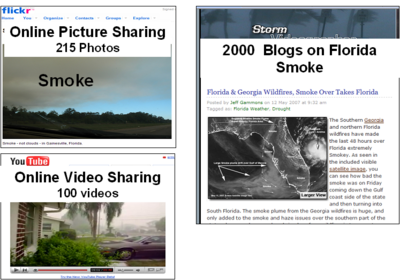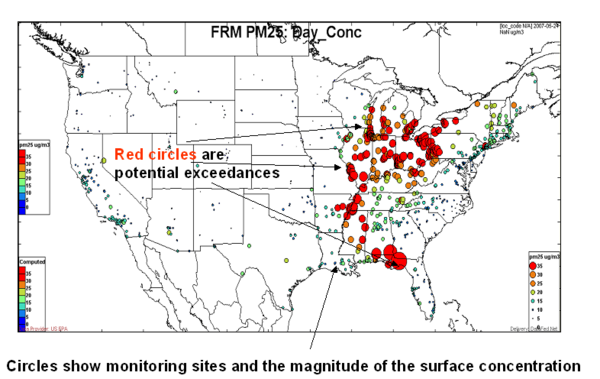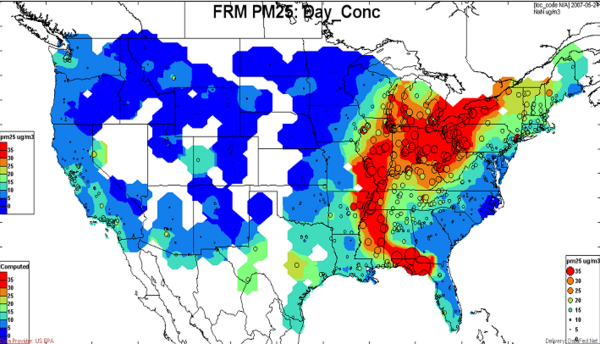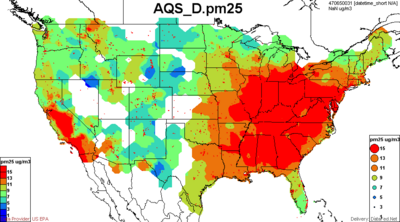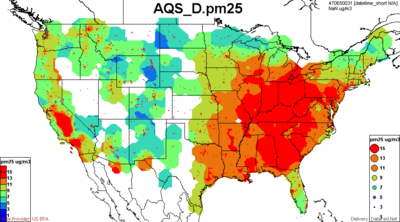Difference between revisions of "NASA ROSES08: Regulatory AQ Applications Proposal- Technical Approach"
| Line 21: | Line 21: | ||
In the first step it is established whether a site is in potential violation of the PM2.5 standard; is the concentration > 35 ug/m3? Only samples that are in non-compliance are qualified for EE status flag. | In the first step it is established whether a site is in potential violation of the PM2.5 standard; is the concentration > 35 ug/m3? Only samples that are in non-compliance are qualified for EE status flag. | ||
Next, qualitative or quantitative evidence is gathered and presented showing that the event could have been caused by a source that is '''''not reasonably controllable or preventable''''' | Next, qualitative or quantitative evidence is gathered and presented showing that the event could have been caused by a source that is '''''not reasonably controllable or preventable''''' | ||
| + | |||
| + | ====Purpose of Component==== | ||
| + | '''One needs to establish that there is a potential pollutant source which is not controllable or preventable, such as forest fires, dust storms, or pollution from other, extrajurisdictional regions.''' | ||
| + | |||
| + | The EE Rule identifes different [[EPA_Example_EE_Categories| categories of uncontrollable]] events: | ||
| + | * Exceedances Due to Transported Pollution (Transported African, Asian Dust; Smoke from Mexican fires; Smoke & Dust from Mining, Agricultural Emissions) | ||
| + | * Natural Events (Nat. Disasters.; High Wind Events; Wildland Fires; Stratospheric Ozone; Prescribed Fires) | ||
| + | * Chemical Spills and Industrial Accidents; Structural Fires; Terrorist Attack | ||
| + | |||
| + | (j) Exceptional event means an event that affects air quality, is not reasonably controllable or preventable, is an event caused by human activity that is unlikely to recur at a particular location or a natural event, and is determined by the Administrator in accordance with 40 CFR 50.14 to be an exceptional event. It does not include stagnation of air masses or meteorological inversions, a meteorological event involving high temperatures or lack of precipitation, or air pollution relating to source noncompliance. | ||
| + | ====Component Form, Function, …==== | ||
| + | |||
| + | ===== Reports of the Event from Media and General Public ===== | ||
| + | The general public provides additional qualitative observations of exceptional events shared through internet-accessible blog posts, photos through Flickr and videos through YouTube. | ||
| + | |||
| + | [[Image:0705_EE_Web20.png|400px]]<br> | ||
| + | |||
| + | Exceptional events are inherently noticeable because of the intensity of the short-time emissions and due to the unusual impacts they have on the atmospheric environment. The recent proliferation of continuously recording webcams, individual digital photographs and home videos as well as personal blog reports now constitute a significant new information source. Most of these observations are almost immediately placed on the internet, shared into internet-based repositories like YouTube for videos, Flickr for images and blogs for personal accounts. Given the high density and short response of these sensors to the exceptional events it is said that the Earth, has now acquired a "skin" for the detection of changes in the environment. | ||
| + | |||
| + | |||
| + | ===== Measured PM2.5 Concentration Showing Exceedance (>15ug/m3 or > 35ug/m3 ) - Site specific===== | ||
| + | '''The first step is to establish that a sample is a likely contributor to noncompliance. A site is in noncompliance if the 98 percentile of the PM2.5 concentration over a three year period is over 35 ug/m3. However, a sample may be in compliance even if the PM2.5 concentration is > 35ug/m3, provided that such values occur less than 2 percent of the time.''' | ||
| + | |||
| + | |||
| + | '''Screening for Potential PM2.5 Exceedances:''' The PM2.5 samples that are potential contributors to non-compliance can be determined visually and qualitatively by the PM2.5 [http://webapps.datafed.net/datafed.aspx?page=ARC/FRMPM25_Day&datetime=2007-05-24T18:00:00 Data Browser Tool]. The data browser tool has a map view and a time series view. The map view shows the PM2.5 concentration as colored circles for each station for a specific date. The time view shows the concentration time series for a selected site. The selection of time for the map view can be accomplished by entering the desired date in the date box or clicking the date in the time view. The selection of the station for the time series is accomplished either by choosing from the station list box or clicking on the station in the map view. The coloring of the PM2.5 concentration values (circles) is adjusted such that the concentrations above 35ug/m3 are shown in red. This provides an easy and obvious (maybe not for Neil) way to identify the candidate samples for noncompliance. | ||
| + | |||
| + | [[Image:070524_PM25Exceed_Arrow.png|600px]]<br> | ||
| + | [[Image:070524_FRM_PM25_Day_Slide.png|600px]]<br> | ||
| + | |||
| + | ===== Measured PM2.5 Speciation Data for the Event Day - Site Specific (EC/OC/SO4...)===== | ||
| + | |||
| + | A compelling line of evidence for establishing a causal relationship is through the chemical fingerprints of aerosol samples. This speciated aerosol monitoring data can be used to indicate unusual exceptional status based on unusual chemical composition, e.g. organics for smoke and sulfates for non-exceptional sources. Speciated aerosol monitoring data can be used to indicate unusual exceptional status based on unusual chemical composition, e.g. organics or smoke, and soil components for wind-blown dust. Speciated aerosol composition data provide strong evidence for the impact of smoke on ambient concentrations. The figures below show the chemical composition data for sulfate and organics, respectively for May 24 and May 27. <br> | ||
| + | [[Image:070524_VIEWS_SO4fwEmission.png|600px]]<br> | ||
| + | |||
| + | ===== Location of Flagged Monitor Site and Suspected Source Area===== | ||
| + | Need maps of source and monitor site. | ||
| + | |||
| + | ====Inputs and Outputs (Data/Evidence)==== | ||
| + | |||
| + | ====Tools and Data Used ==== | ||
| + | |||
| + | ====Participants ==== | ||
| + | |||
====Event Detection/Description Challenges==== | ====Event Detection/Description Challenges==== | ||
Revision as of 13:44, July 6, 2008
Air Quality Cluster > Applying NASA Observations, Models and IT for Air Quality Main Page > Proposal | NASA ROSES Solicitation | Context | Resources | Schedule | Forum | Participating Groups
Summary
A description of the key, central objectives of the proposal in terms understandable to a nonspecialist;
A concise statement of the methods/techniques proposed to accomplish the stated research objectives; and
- Fan-in/Fan-out Architecture
- Service Oriented Architecture
- Application to primary and reused in secondary DSS's
A statement of the perceived significance of the proposed work to the objectives of the solicitation and to NASA interests and programs in general.
- Better air quality management decisions
- Wider distribution of NASA products
- Demonstration of GEOSS concept
Exceptional Event DSS
A: Event Description
In the first step it is established whether a site is in potential violation of the PM2.5 standard; is the concentration > 35 ug/m3? Only samples that are in non-compliance are qualified for EE status flag. Next, qualitative or quantitative evidence is gathered and presented showing that the event could have been caused by a source that is not reasonably controllable or preventable
Purpose of Component
One needs to establish that there is a potential pollutant source which is not controllable or preventable, such as forest fires, dust storms, or pollution from other, extrajurisdictional regions.
The EE Rule identifes different categories of uncontrollable events:
- Exceedances Due to Transported Pollution (Transported African, Asian Dust; Smoke from Mexican fires; Smoke & Dust from Mining, Agricultural Emissions)
- Natural Events (Nat. Disasters.; High Wind Events; Wildland Fires; Stratospheric Ozone; Prescribed Fires)
- Chemical Spills and Industrial Accidents; Structural Fires; Terrorist Attack
(j) Exceptional event means an event that affects air quality, is not reasonably controllable or preventable, is an event caused by human activity that is unlikely to recur at a particular location or a natural event, and is determined by the Administrator in accordance with 40 CFR 50.14 to be an exceptional event. It does not include stagnation of air masses or meteorological inversions, a meteorological event involving high temperatures or lack of precipitation, or air pollution relating to source noncompliance.
Component Form, Function, …
Reports of the Event from Media and General Public
The general public provides additional qualitative observations of exceptional events shared through internet-accessible blog posts, photos through Flickr and videos through YouTube.
Exceptional events are inherently noticeable because of the intensity of the short-time emissions and due to the unusual impacts they have on the atmospheric environment. The recent proliferation of continuously recording webcams, individual digital photographs and home videos as well as personal blog reports now constitute a significant new information source. Most of these observations are almost immediately placed on the internet, shared into internet-based repositories like YouTube for videos, Flickr for images and blogs for personal accounts. Given the high density and short response of these sensors to the exceptional events it is said that the Earth, has now acquired a "skin" for the detection of changes in the environment.
Measured PM2.5 Concentration Showing Exceedance (>15ug/m3 or > 35ug/m3 ) - Site specific
The first step is to establish that a sample is a likely contributor to noncompliance. A site is in noncompliance if the 98 percentile of the PM2.5 concentration over a three year period is over 35 ug/m3. However, a sample may be in compliance even if the PM2.5 concentration is > 35ug/m3, provided that such values occur less than 2 percent of the time.
Screening for Potential PM2.5 Exceedances: The PM2.5 samples that are potential contributors to non-compliance can be determined visually and qualitatively by the PM2.5 Data Browser Tool. The data browser tool has a map view and a time series view. The map view shows the PM2.5 concentration as colored circles for each station for a specific date. The time view shows the concentration time series for a selected site. The selection of time for the map view can be accomplished by entering the desired date in the date box or clicking the date in the time view. The selection of the station for the time series is accomplished either by choosing from the station list box or clicking on the station in the map view. The coloring of the PM2.5 concentration values (circles) is adjusted such that the concentrations above 35ug/m3 are shown in red. This provides an easy and obvious (maybe not for Neil) way to identify the candidate samples for noncompliance.
Measured PM2.5 Speciation Data for the Event Day - Site Specific (EC/OC/SO4...)
A compelling line of evidence for establishing a causal relationship is through the chemical fingerprints of aerosol samples. This speciated aerosol monitoring data can be used to indicate unusual exceptional status based on unusual chemical composition, e.g. organics for smoke and sulfates for non-exceptional sources. Speciated aerosol monitoring data can be used to indicate unusual exceptional status based on unusual chemical composition, e.g. organics or smoke, and soil components for wind-blown dust. Speciated aerosol composition data provide strong evidence for the impact of smoke on ambient concentrations. The figures below show the chemical composition data for sulfate and organics, respectively for May 24 and May 27.
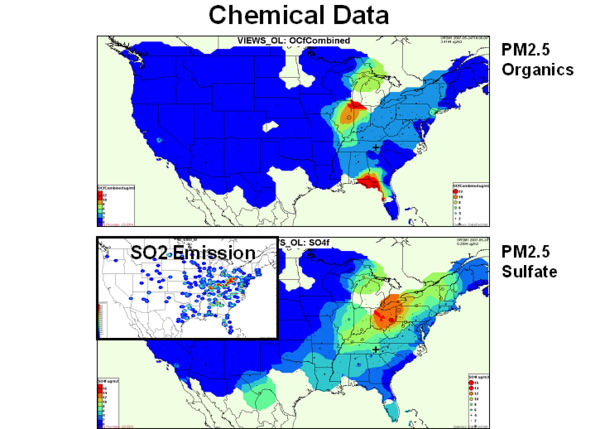
Location of Flagged Monitor Site and Suspected Source Area
Need maps of source and monitor site.
Inputs and Outputs (Data/Evidence)
Tools and Data Used
Participants
Event Detection/Description Challenges
Science-technical Challenges
- What are key EE indicator parameters? (a) Satellite images, data (b) Airnow PM2.5, O3; (c) Folk-sensors
- When to gather the descriptive info on the EE? (a) Realtime, (b) Post-analysis, (c) Both?
- How to gather EE descriptor info? (a) dedicated sensors (b) (c) virtual monitoring dashboard/console of relevant parameters
Organizational Challenges
- Who should package EE description? (a) A designated, national EE 'descriptor', (b) Individual State 'observer/descriptor'. (3) Scientist/analysts as a virtual workgroup/wiki?
- Who should be receiving/notified with the EE description/trigger? (a) State analysts (b) public (c) Virtual workgroup
- Which agencies, orgs should be in; what governance on the EE detection/description? (a) fully open, all orgs, any time (b) (c) Core EE group + ad-hoc
Implementation Challenges
- What systems architecture? (a) ad-hoc, by State (b) dedicated EE detection system (c) system of systems
- Who develops, implements applies the tools, methods
- How is the entire activity to be 'connected'?
B: Clear Causal Relationship between the Data and the Event
The third, main analysis step, provides key quantitative information for demonstrating a clear causal relationship between the measured exceedance value and the exceptional event.
Science-technical Challenges
Organizational Challenges
Implementation Challenges
C: The Event is in Excess of the "Normal" Values
Next, the sample is evaluated whether the measured high value is in excess of the normal, historical values. If not, the sample is not exceptional.
D: The Exceedance or Violation would not Occur, But For the Exceptional Event
Finally, the contribution of the exceptional source to the sample is compared to 'normal' anthropogenic sources. Only samples where the exceedances occur but for the contribution of the exceptional source qualify for EE flag.
- General Goal and Framework needs to satisfy EE Rule
- Methods of EE flagging can be developed based on the EE Rule and constrained by the available data/analysis resources
- EE DSS consists of:
- EE Flagging template - lays out sequence and possible lines of evidence
- Tools (based on template) that help preparing flags (States), approving (EPA Regions), deciding (Federal EPA)
The DSS needs to be robust and up-to-date, continuously or in batch mode. Need to request to EPA to expose the FRM PM2.5 and Ozone data, say every 3 months, after the sampling
Members of the 'Core' network need to agree to provide robust service of data and tools.
Architecture
The design philosophy is of fan in-fan out. Any data is applicable to multiple benefit areas. Any benefit area needs multiple data.
Primary Decision-Support Systems
- DataFed - Husar - Exceptional Events. Fan in: 50 States -> 10 EPA Regions -> 1 Federal EPA. Each transmits different pieces of information and we need to determine those pieces.
Exceptional Events are distributed in space, need a wide variety of data and include a variety of people therefore they are good candidates for the modern decision-support systems. Because fan in - fan out data flow architecture is so broad it can help other decision support application areas.
Many data, many analyses, many participants
Other Decision-Support Systems
Same fan in - fan out data flow architecture can be used for different decision-support systems.
- VIEWS - Brett/Shawn - Regional Haze
- BlueSky - Sean - Smoke
- BAMS - McHenry - Air Quality Forecasting for the public
- HTAP - Keating - Hemispheric Transport Policy
Information Sources
Generic Processing Routines and Tools
Application to Other DSS's
From NRA
As the main body of the proposal, this section should cover the following material:
- Objectives of the proposed activity and relevance to NASA’s Strategic Goals and Outcomes given in Table 1 in the Summary of Solicitation of this NRA;
- Strategic Subgoal 3A: Study planet Earth from space to advance scientific understanding and meet societal needs. - 3A.7 Expand and accelerate the realization of societal benefits from Earth system science.
- Methodology to be employed, including discussion of the innovative aspects and rationale for NASA Earth research results to be integrated;
- Systematic approach to integrate Earth science results into the decision-making activity (existing or new) and to develop and test the integrated system and address integration problems (technical, computational, organizational, etc.);
- Approach to quantify improvements in the system performance, including characterization of risk and uncertainties;
- Approach to quantify (or quantitatively estimate) the socioeconomic value and benefits from the resulting improvements in decision-making;
- Challenges and risks affecting project success (technical, policy, operations, management, etc.) and the approach to address the challenges and risks; and
- Relevant tables/figures that demonstrate key points of the proposal.
Proposals seeking to create a new decision-making activity should describe the tool, system, assessment, etc. in detail, including the decision analysis, factors, unique roles for Earth science research results, and other pertinent information.
From NASA Proposer Guidebook - Technical/Science/Management Section
[Ref.: Appendix B, Parts (c)(4), (c)(5), and in-part (c)(6)] As the main body of the proposal, this section must cover the following topics in the order given, all within the specified page limit. Unless specified otherwise in the NRA, the limit is 15 pages using the default values given in Section 2.3.1:
- The objectives and expected significance of the proposed research, especially as related to the objectives given in the NRA;
- The technical approach and methodology to be employed in conducting the proposed research, including a description of any hardware proposed to be built in order to carry out the research, as well as any special facilities of the proposing organization(s) and/or capabilities of the Proposer(s) that would be used for carrying out the work. (Note: ref. also Section 2.3.10(a) concerning the description of critical existing equipment needed for carrying out the proposed research and the Instructions for the Budget Justification in Section 2.3.10 for further discussion of costing details needed for proposals involving significant hardware, software, and/or ground systems development, and, as may be allowed by an NRA, proposals for flight instruments);
- The perceived impact of the proposed work to the state of knowledge in the field and, if the proposal is offered as a direct successor to an existing NASA award, how the proposed work is expected to build on and otherwise extend previous accomplishments supported by NASA;
- The relevance of the proposed work to past, present, and/or future NASA programs and interests or to the specific objectives given in the NRA;
- To facilitate data sharing where appropriate, as part of their technical proposal, the Proposer shall provide a data-sharing plan and shall provide evidence (if any) of any past data-sharing practices.
The Scientific/Technical/Management Section may contain illustrations and figures that amplify and demonstrate key points of the proposal (including milestone schedules, as appropriate). However, they must be of an easily viewed size and have self-contained captions that do not contain critical information not provided elsewhere in the proposal.
